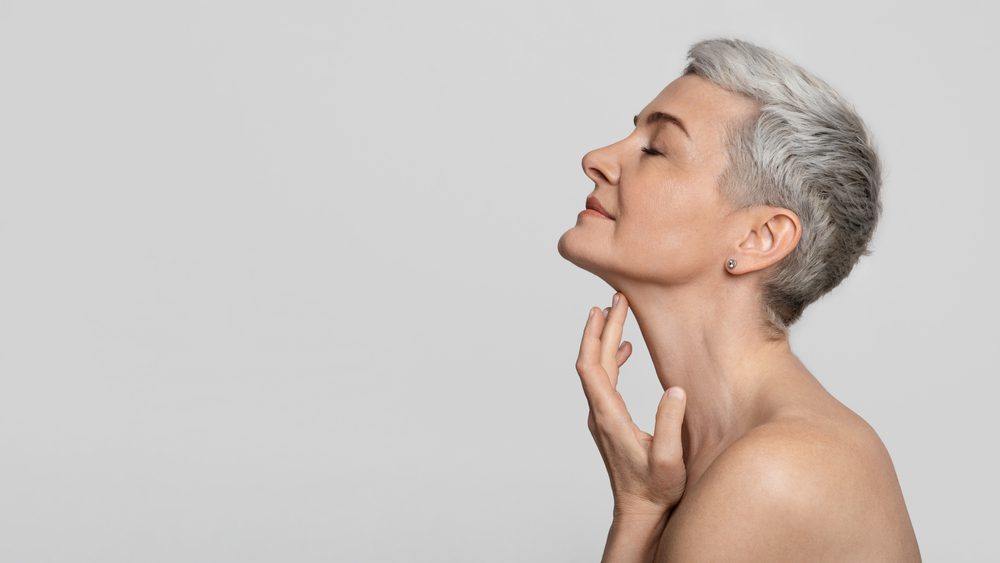Less invasive procedure developments have come on in leaps and bounds in recent years.
Among the possibilities, injectable botulinum toxin treatments have changed the game as an option for minimising lines and wrinkles and injectable dermal filler can improve or restore facial volume.
Now, the industry is turning its focus to better solutions for improving other facial conditions that happen to most of us as we get older.
It’s well known that as we age, our skin loses collagen and elastin. Among other things, these elements are responsible for the plumpness and underlying structure that supports our skin.
For many of us, that evolution can cause skin to become lax and slightly slack, losing definition and causing drooping, often around the forehead, cheeks and jawline.
It’s why ‘fighting the sag’ is the new frontier of appearance medicine. New options aim to define the face and sharpen the jawline for those not willing or able to undergo more invasive face-lift surgery where incisions are created to lift the face and excess skin is surgically removed.
Experts in both cosmetic surgery and minimally non-invasive appearance medicine treatments, Me Clinic offers a range of treatments and is home to some of Australia’s most experienced and renowned cosmetic surgeons and cosmetic physicians. The team at Me Clinic shared their insight around thread lifts and what’s involved:
What is a thread lift?
Known in some circles as a ‘lunch-time lift’ because of its minimal downtime when compared with a classic surgical face-lift procedure, a thread lift involves inserting small sutures with barbs or cones beneath the skin. These are designed to cause tension beneath the skin’s surface, repositioning skin and giving a lifting and tightening effect. The number of sutures applied depends on your skin’s laxity and condition and the result you’re after.
Their versatility means threads can be used in a variety of areas including cheeks, nasolabial folds, jowls and neck but they are particularly effective around the mid-face and areas of the face and neck.
As research has shown, the thread lift procedure can also trigger a natural healing response that stimulates the production of collagen in the skin which may also result in increased firmness. Due to this collagen-stimulating effect, benefits can include the improvement of sagging skin and heaviness in the lower part of the face and jawline.

Who is a good candidate for a thread lift?
According to Me Clinic, a good candidate is anyone with good skin quality that is seeking a tightening effect of the face and neck. Usually patients between the ages of 35 to 65 are suitable, but this will also depend on the patient’s skin quality.
While threads provide versatility, a shorter recovery and are more affordable than more invasive options, they also provide a more subtle and natural-looking lift. It’s important patients seeking a more dramatic result maintain realistic expectations for the procedure, and this is where expert guidance is crucial.
How long does the treatment last?
In the past, threads were made of permanent material that wasn’t well tolerated by the body. Now, the threads are dissolvable, making them safer and more effective. They are designed to eventually be broken down and absorbed by the body before they stimulate the growth of collagen around the area.
This collagen can still present in the location treated two years after the procedure, with an ‘improved appearance’ at this time too. A follow up with the doctor that provided treatment is advised after 24 months to review your procedure and assess whether further treatment is required.
Are there any risks involved?
In terms of pain, Me Clinic advises local anesthetic is used during insertion of the suture to avoid pain, so there is very minimal discomfort.
Like many procedures of this type there are potential side effects. Me Clinic reports some mild swelling as the most common side effect, usually lasting about 2-3 days. Other uncommon side effects include infection, minimal acute inflammatory tissue reaction, and pain. Bruising may also occur. Sometimes, a slight dimpling, depression or skin irregularity may appear at the entry points where the threads are placed. This should disappear a few days after treatment.
The beauty of thread lifts are that they can be personalised to the result you are seeking, but this also means due to variation in placement, type of threads used, the size and scope of the area you’re having treated and the risk of potential side effects, it is imperative to seek out an experienced treatment provider.
- All surgery has risks and Me Clinic recommends seeking a second medical opinion.
- For more information on Thread Lifts visit Me Clinic.
MiNDFOOD promotion







